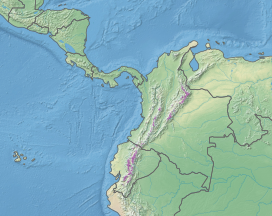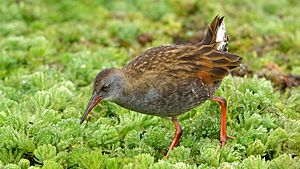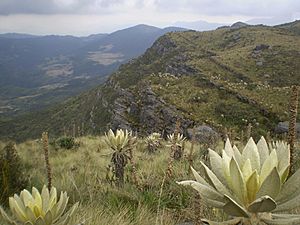Northern Andean páramo facts for kids
Quick facts for kids Northern Andean páramo (NT1006) |
|
|---|---|

Landscape in Nevado del Ruiz, Colombia
|
|

Location in northwest South America (purple shading)
|
|
| Ecology | |
| Realm | Neotropical |
| Biome | Montane grasslands and shrublands |
| Geography | |
| Area | 30,044 km2 (11,600 sq mi) |
| Countries | Colombia, Ecuador |
| Coordinates | 2°20′38″N 76°23′02″W / 2.344°N 76.384°W |
| Climate type | Cfb warm temperate; fully humid; warm summer |
The Northern Andean páramo (NT1006) is a special type of ecoregion found high up in the Andes mountains. It's a unique area with special plants and animals that live above the forest line but below the snow line. You can find it in Colombia and Ecuador.
Long ago, when the Earth was colder, these páramo areas were lower down and connected. But as the climate got warmer during the Holocene epoch (our current time), the páramos moved higher up the mountains. This made them smaller and separated from each other.
Because they are isolated, many rare or endangered species live here. Some of these species can only be found in a very small area, like on one mountain. The Northern Andean páramo is still quite well-preserved. However, it faces threats from too much animal grazing and farming.
Contents
Geography: Where is the Páramo?
Location and Size
The Northern Andean páramo wraps around the highest peaks of the Andes mountains. It stretches from north-central Colombia down to central Ecuador. This special area is found between the treeline (where trees stop growing) and the snowline (where snow stays all year).
The total area of this páramo is about 3 million hectares (that's about 7.4 million acres!). You can find the páramo at heights from 3,000 to 3,500 meters (about 9,800 to 11,500 feet) up to the snow line at 5,000 meters (about 16,400 feet). Imagine them as islands of grasslands and shrubs, surrounded by a "sea" of cloud forests lower down the mountains.
Soils: The Ground Beneath Your Feet
The Andes mountains have many different types of rocks, so the soils in the páramo are also very varied. Most of these soils are quite young.
- Lower areas (subpáramo): The soil here is dark and has lots of organic matter (from dead plants). It's not very acidic.
- Middle areas (grass páramo): These soils are deep, dark, and often wet. They are rich in organic matter, like peat.
- Highest areas (superpáramo): The soil here is thin and rocky, with lots of sand. It doesn't hold water well and isn't very fertile.
Climate: Weather in the Mountains
The Northern Andean páramos are generally humid all year. They get moisture from rain, clouds, and fog as air moves up the mountains. The amount of rainfall can vary a lot, from 500 to 3,000 millimeters (about 20 to 118 inches) each year.
Unlike some other páramos, this area doesn't have a clear dry season. Temperatures in the Northern Andean páramos can change a lot in one day. It might drop below freezing at night but rise to 30°C (86°F) during the day. You might experience rain, snow, and fog, followed by sunny skies and warm temperatures, all in the same day!
Ecology: Life in the Páramo
The Northern Andean páramo is part of the Neotropical realm, which covers much of Central and South America. It's a type of montane grasslands and shrublands biome, meaning it's a high-altitude area with grasses and shrubs.
Plants and animals here have special ways to live in the cold, dry conditions of these high mountains. Many species found here are endemic, meaning they live only in this specific area and nowhere else. This is especially true for species on isolated mountain peaks.
Origins: How the Páramo Formed
The Andes mountains started to form millions of years ago. But in the northern part, they didn't reach their current height until about four to five million years ago. When the land rose above the treeline, new types of plants began to grow, forming the first páramo vegetation.
Over time, the Earth went through many cold, dry ice ages and warmer, wetter periods. During cold times, the páramo areas moved lower down the mountains and connected. When it got warmer, they moved higher up and became separated "islands" again. This constant movement helped create a mix of plant species. Some came from tropical areas, and others from colder northern regions. Many unique species developed in each isolated páramo.
About 14,000 years ago, it was much colder, and the páramo started at a much lower height. It covered a much larger area, and most of today's separate páramo areas were connected. As the Earth warmed about 10,000 years ago (at the start of the Holocene epoch), the forest line moved up, pushing the páramo higher and making it smaller.
Flora: Amazing Plants

The plants in the páramo include tall alpine grasslands, wet bogs, and open meadows. The line where trees stop and páramo begins is usually higher on the wetter, windy side of the mountains.
Many scientists believe that the treeless grasslands of the páramo might have been created or kept that way by humans. People might have cut, burned, or grazed animals there. The plants here are quite new, having appeared in the last 4 million years. While many páramos share the same types of plants (genera), they have many unique species. In fact, 86% of the flowering plants here are found nowhere else!
- Subpáramo: This is the transition zone between the forest and the grasslands, around 3,000-3,500 meters (9,800-11,500 feet) high. You'll find small, scattered trees, then shrubs, dwarf shrubs, grasses, and herbs.
- Grass páramo: Growing at about 3,500-4,100 meters (11,500-13,500 feet), this area is mostly covered by tall, clumpy grasses like Calamagrostis or Festuca. It also has many small herbs. You can also find rocky areas and wet places like swamps or bogs with their own special plants.
- Superpáramo: At the highest levels, the plants here are adapted to the harshest conditions. They are very small and include gymnosperms (like conifers), mosses, and lichens. This area has a very high number of endemic species.
Fauna: Unique Animals

The Northern Andean páramo is home to many animals, including several endangered species.
- Endangered mammals: These include the Hammond's rice rat (Mindomys hammondi), the mountain tapir (Tapirus pinchaque), and the woodland Oldfield mouse (Thomasomys hylophilus).
- Endangered reptiles: Examples are the Colombian lightbulb lizard (Riama columbiana) and Riama petrorum.
- Endangered birds: Some rare birds are Apolinar's wren (Cistothorus apolinari), the black-breasted puffleg (Eriocnemis nigrivestis), and the Bogotá rail (Rallus semiplumbeus).
- Endangered amphibians: This region is very important for amphibians. Many types of painted frogs (Atelopus species), marsupial frogs (Gastrotheca species), and robber frogs (Pristimantis species) are endangered here.
Status: Protecting the Páramo

The World Wildlife Fund (WWF) says the Northern Andean páramo is "Relatively Stable/Intact." This is good news, but it still faces challenges.
The páramo is super important because it's a major source of water for the Andean highlands and many areas below. It provides a steady flow of high-quality water to rivers.
Humans have lived in the páramo for a very long time, even before Columbus arrived. In the past, people often just let their animals graze freely. More recently, however, the border between the natural forest and the páramo has changed a lot. This is due to logging (cutting down trees) and intense grazing by livestock. It's now hard to tell what is natural grassland and what was created by humans.
There's also more farming, more intense grazing, pine tree plantations, and tourism. All these activities can affect how the páramo holds and releases water. In some places, people grow potatoes and beans, which needs draining the wet soils.
Luckily, many parts of the Northern Andean páramo are protected. These include:
- The Cayambe-Coca Ecological Reserve
- The Cinturon Andino Cluster Biosphere Reserve
- Chingaza National Natural Park
- Sumapaz Páramo National Park
- Sierra Nevada del Cocuy Chita o Guican National Natural Park
- Lake Iguaque Flora and Fauna Sanctuary
- Los Nevados National Natural Park
- Las Hermosas National Natural Park
Sources
See also
 In Spanish: Páramo del norte de los Andes para niños
In Spanish: Páramo del norte de los Andes para niños


